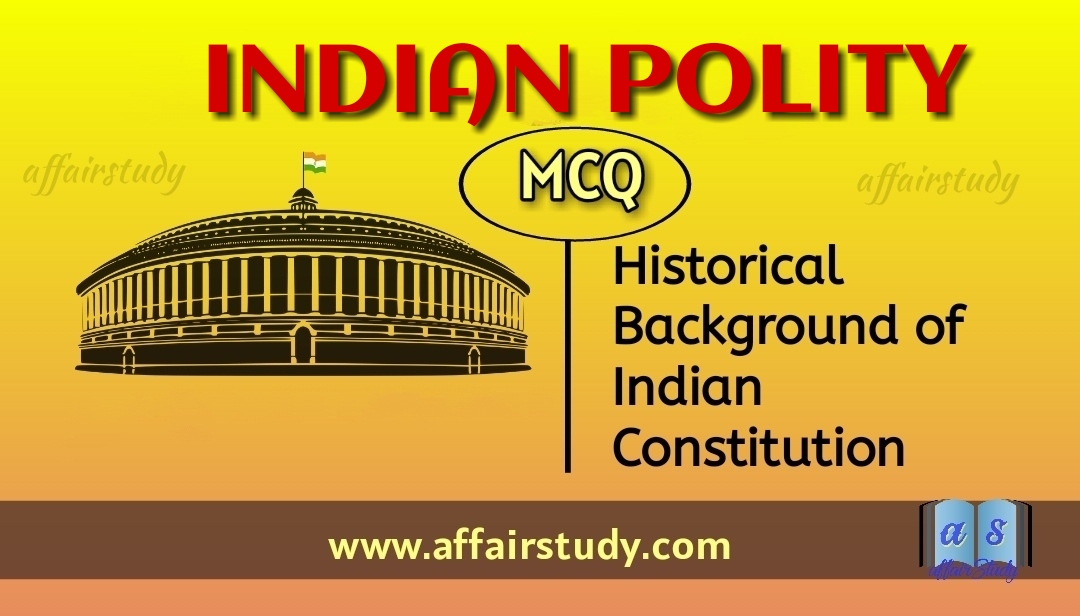MCQ on Historical Background of Indian Constitution
Constitutional Development of India | Indian Polity-MCQ
MCQ on Historical Background of Indian Constitution | Chapter - 01
In this section, we are providing the most important MCQs and answers of the Chapter Historical Background of Indian Constitution.
This MCQ on Constitutional Development of India is very helpful for any competitive exam.
Polity Historical Background MCQ Questions:
1. Which of the following exercised the most profound influence in framing the Indian Constitution
The Government of India act, 1935
2. By virtue of which act, dyarchy was introduced in India?
Dyarchy was introduced by the act of Government of India Act, 1919.
3. The first attempt to introduce a representative popular element in the governance of India was made through
Indian Council Act, 1861
4. The idea of the constitution of India was first of all given by
The idea of the constitution of India was first of all given by M N Roy.
5. Which of the following acts introduced communal electorate in India?
Indian Council Act, 1909.
6. Two independent states of India and Pakistan was created by
The Indian Independence Act.
7. The first attempt at drafting a Dominion status Constitution for India was made in the
Minto Morley Reforms
8. Who was the first foreign minister of free India
Jawaharlal Nehru.
9. In the federation under the Act of 1935 residuary powers was given to the
Governor General.
10. The Constitution of India was enacted by a Constituent Assembly set up
Under the Cabinet Mission Plan, 1946.
11. A bill in the Imperial Legislative Council for compulsory and free primary education was introduced by
A bill in the Imperial Legislative Council for compulsory and free primary education was introduced by G.K. Gokhale.
12. The Constituent Assembly which framed the Constitution for Independent India was set up in
The Constituent Assembly which framed the Constitution for Independent India was set up in 1946.
13. Who among the following was not a member of the Constituent Assembly established in July 1946?
Mahatma Gandhi.
Four lions.
The Constitution of India was promulgated on January 26, 1950 because this day was being celebrated as the Independence Day since 1929.
The office of Governor General of India was created by Charter Act, 1833.
The Constitution of India came into force on January 26, 1950.
The Supreme Court of India was set up by the Regulating Act, 1773.
The Indian independence Bill received the Royal Assent on July 18, 1947.
John Simson .
The Charter Act of 1833.
Governmentof India Act, 1935.
Mahatma Gandhi.
14. Which of the following was adopted from the Maurya dynasty in the emblem of
Government of India?
Four lions.
15. The Constitution of India was promulgated on January 26, 1950 because
The Constitution of India was promulgated on January 26, 1950 because this day was being celebrated as the Independence Day since 1929.
16. The office of Governor General of India was created by
The office of Governor General of India was created by Charter Act, 1833.
17. The Constitution of India came into force on
The Constitution of India came into force on January 26, 1950.
18. The Supreme Court of India was set up by the
The Supreme Court of India was set up by the Regulating Act, 1773.
19. The Indian independence Bill received the Royal Assent on
The Indian independence Bill received the Royal Assent on July 18, 1947.
20. Who was not a member of Cabinet Mission?
John Simson .
21. Though which of the following were commercial activities of the East India Company finally put to an end
The Charter Act of 1833.
22. Which of the following Act was described by Jawahar Lal Nehru as 'Charter of Slavery'?
Governmentof India Act, 1935.
Read Also...








0 Comments
I hope you liked the Post. Share it with your friends and if you have any suggestion, feel free to enter your comment in the comment box.